Greek Salad Recipe: Simple & Healthy

Ever wondered how to bring the sun-soaked flavors of the Mediterranean to your table in minutes? A Greek salad might be your answer. This refreshing dish combines crisp vegetables, tangy feta, and briny olives in a harmony that’s both delicious and nutritious. But what makes a truly authentic Greek salad, and how can you perfect it at home?
In this guide, you’ll discover the secrets to creating a Greek salad that transports your taste buds straight to the Aegean coast. From selecting the freshest ingredients to mastering the perfect dressing, we’ll walk you through every step of crafting this healthy Mediterranean staple.
Whether you’re looking for a light lunch, a vibrant side dish, or a colorful addition to your dinner spread, this Greek salad recipe is sure to become a go-to in your culinary repertoire. Get ready to impress your family and friends with a salad that’s as simple to make as it is satisfying to eat.
Key Takeaways
- Greek salad combines fresh vegetables, feta cheese, and olives for a healthy Mediterranean dish
- The recipe is quick to prepare, taking only a few minutes to assemble
- A serving contains about 230 calories and is rich in nutrients
- The salad is naturally gluten-free and can be made dairy-free by omitting the feta
- Proper storage can keep the salad fresh for 1-2 days if undressed
- Customization options allow for personal taste preferences and dietary needs
- The dressing combines olive oil, red wine vinegar, and herbs for authentic flavor
What is Greek Salad and Its Origins?
Greek salad, also called horiatiki, is a key dish in Greek food. It’s made with simple, fresh ingredients for a tasty meal. Let’s look at its history and what makes it special.
A Brief History of Greek Salad
Greek salad has been around for less than 100 years. Tomatoes, a key part, were introduced to Greece in 1818. The salad as we know it today started in the 1960s. An Athens restaurant owner added feta cheese to get around price limits.
Traditional Ingredients and Their Significance
A real Greek salad has cucumbers, tomatoes, green bell peppers, red onions, Kalamata olives, and feta cheese. It’s dressed with olive oil and oregano. Each piece is important for the salad’s unique taste.
| Ingredient | Percentage | Significance |
|---|---|---|
| Tomatoes | 50% | Provides juicy sweetness |
| Cucumbers | 20% | Adds crunch and freshness |
| Onion | 15% | Offers sharp flavor |
| Feta cheese | 10% | Brings creamy texture and saltiness |
| Olives | 5% | Provides briny depth |
Greek salad is a big part of the Mediterranean diet. It’s known for being very healthy. It has protein from feta, healthy fats from olive oil, and lots of veggies.
Health Benefits of Greek Salad
Greek salad is full of good stuff for your body. It has fresh veggies, olive oil, and tangy feta. This mix makes a tasty and healthy meal.
Nutritional Breakdown of Key Ingredients
Tomatoes are full of vitamins A and C. Cucumbers help you stay hydrated and give you potassium. Red onions have antioxidants and B vitamins.
Kalamata olives are good for your heart and have antioxidants too.
| Ingredient | Key Nutrients | Health Benefits |
|---|---|---|
| Tomatoes | Vitamins A, C, K, B vitamins | Cancer prevention, heart health |
| Cucumbers | Potassium, low calories | Hydration, weight management |
| Red Onions | Flavonoids, Vitamin C | Antioxidant protection |
| Feta Cheese | Calcium, Protein | Bone health, gut health |
| Olive Oil | Monounsaturated fats | Heart health, nutrient absorption |
Supporting Heart Health
The Mediterranean diet, with lots of olive oil and veggies, can lower heart disease risk by up to 30%. Olive oil’s fats are good for your heart. Lemon juice adds flavor and vitamin C.

Benefits for Weight Management
Greek salad is great for keeping your weight in check. It’s low in calories but full of nutrients. Cucumbers and tomatoes are hydrating and low in calories.
The olive oil dressing helps you absorb nutrients without extra calories. This makes it a filling meal choice.
Essential Ingredients for the Perfect Greek Salad
Making a tasty Greek salad starts with picking the right stuff. It needs fresh veggies, tangy cheese, and good olive oil. Let’s look at what makes this salad special.
Fresh Vegetables You Should Use
The base of a great Greek salad is its veggies. Start with 2 cups of halved cherry tomatoes for sweetness. Cut an English cucumber into ¼-inch slices, without seeds, for crunch.
Add a green bell pepper cut into 1-inch pieces for freshness. Thinly slice ½ small red onion for a sharp flavor that balances everything.
Choosing the Right Cheese
Feta cheese is the heart of Greek salad. Use 5 ounces of good feta, cut into ½-inch cubes. This salty cheese adds a tangy flavor that goes well with the veggies.
For a vegan choice, use ¾ cup cooked chickpeas and 1 tablespoon capers instead of feta.
The Importance of Quality Olive Oil
A Greek salad isn’t complete without great olive oil. Use ¼ cup of extra-virgin olive oil in your dressing. This oil adds flavor and healthy fats, key to the Mediterranean diet.
| Ingredient | Quantity | Preparation |
|---|---|---|
| Cherry tomatoes | 2 cups | Halved |
| English cucumber | 1 | ¼-inch slices, seeded |
| Green bell pepper | 1 | 1-inch pieces |
| Red onion | ½ small | Thinly sliced |
| Kalamata olives | ⅓ cup | Pitted |
| Feta cheese | 5 ounces | ½-inch cubes |
| Extra-virgin olive oil | ¼ cup | For dressing |
Remember to add ⅓ cup of pitted Kalamata olives for that Greek touch. Sprinkle dried oregano over your salad before serving. With these ingredients, you’ll make a Greek salad that’s both healthy and tasty.
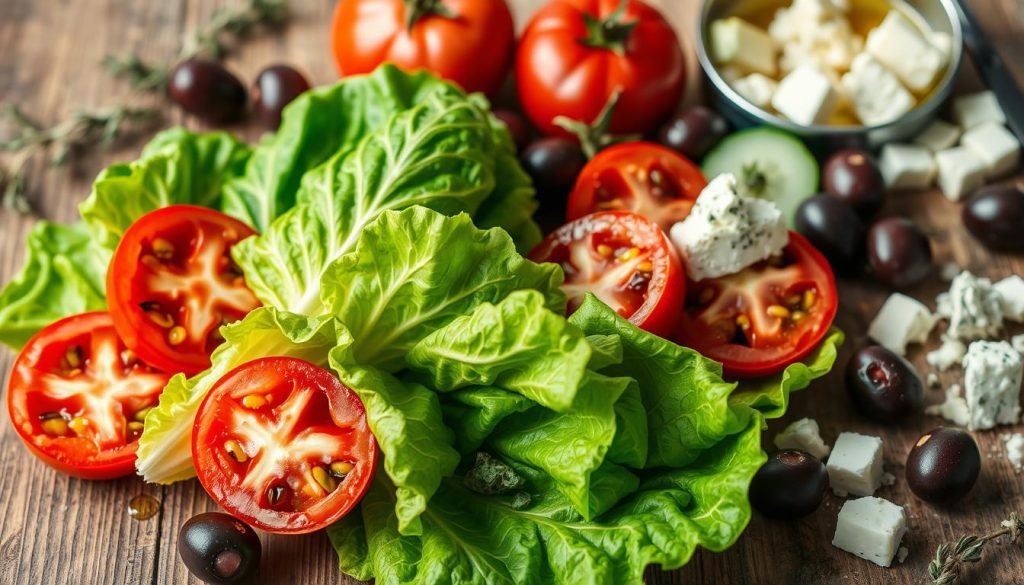
How to Prepare a Delicious Greek Salad
Making a tasty Greek Salad is simple! It’s great for easy recipes and summer parties. Let’s learn how to make this refreshing salad step by step.
Step-by-Step Preparation Guide
First, get your ingredients ready. A classic Greek Salad has cucumbers, tomatoes, bell peppers, red onions, olives, and feta cheese. Cut all veggies into small pieces so they’re all the same size.
Put them in a big bowl. Then, add olives and crumble feta cheese on top.
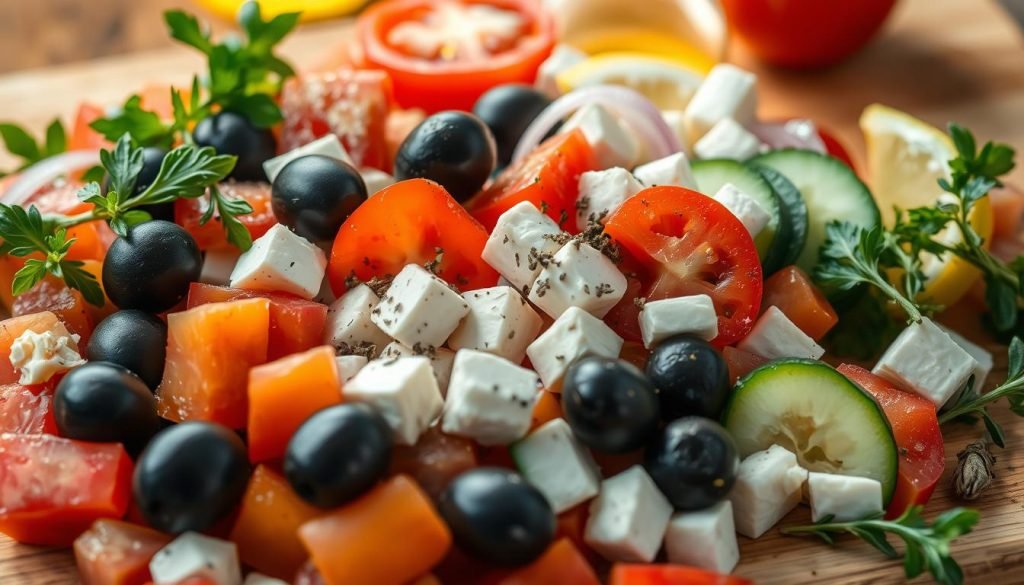
Tips for Cutting Vegetables
For the best texture, cut cucumbers into thin half-moons and tomatoes into quarters. Dice bell peppers and red onions finely. It’s important to make them all the same size for looks and taste.
Prepare your veggies a day or two before. This makes it easy to put your salad together later.
Layering Your Salad for Visual Appeal
To make your salad look good, layer the ingredients. Start with a layer of chopped veggies, then add olives, and finish with feta cheese on top. Just before serving, drizzle with olive oil and red wine vinegar.
This way, your salad will look amazing and taste even better. It’s a great addition to your collection of easy recipes and side dishes!
Classic Greek Salad Dressing Recipe
A perfect Greek Salad Dressing takes your Olive Oil Salad to the next level. It mixes tangy and savory tastes, making a dressing that’s both true to its roots and tasty. With just 7 ingredients and 5 minutes of prep, you’ll have a homemade dressing that beats any restaurant version.
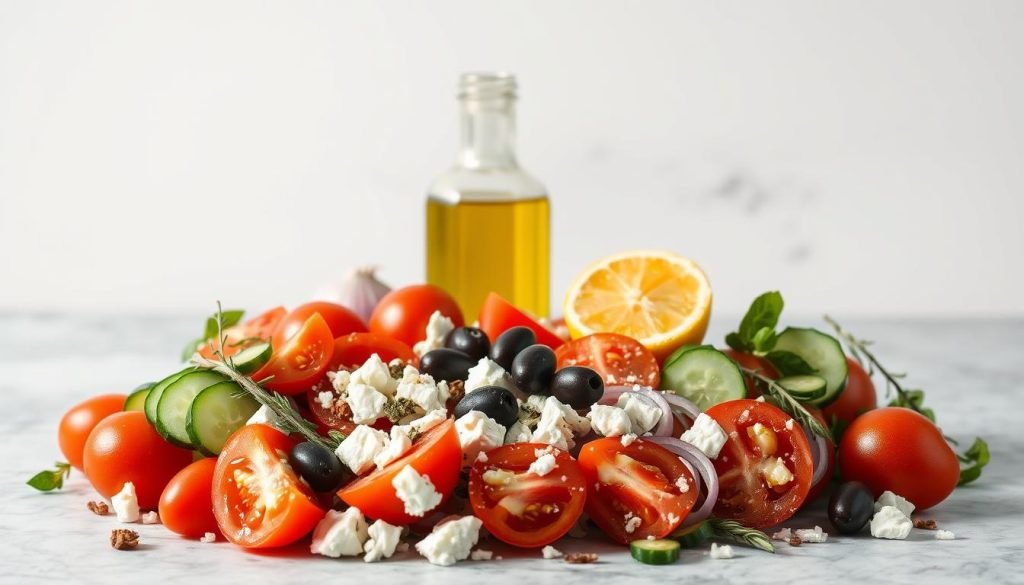
Ingredients for the Ideal Dressing
To make this delicious Greek Salad Dressing, you’ll need:
- ¼ cup extra-virgin olive oil
- 3 tablespoons red wine vinegar
- 1 clove minced garlic
- ½ teaspoon dried oregano
- ¼ teaspoon Dijon mustard
- ¼ teaspoon sea salt
- Freshly ground black pepper to taste
- Lemon juice (optional, for extra zest)
Simple Instructions for Mixing
Making your Greek Salad Dressing is easy:
- Put all ingredients in a 10 oz. Mason jar.
- Close the lid tightly and shake hard for about 30 seconds until mixed well.
- Try it and add more seasoning if you need to.
- Drizzle it over your favorite Olive Oil Salad and enjoy!
This recipe makes 6 servings and can be doubled for bigger groups. Keep any leftover dressing in the fridge for up to 5 days. With an average rating of 4.98 out of 5 from 326 votes, this Greek Salad Dressing is a must-have in your kitchen!
Customizing Your Greek Salad
Greek Salad is a dish you can change to fit your taste. You can make it a big meal or try new tastes. Let’s see how to make your Greek Salad special.
Adding Protein to Make It a Meal
Make your Greek Salad a full meal by adding protein. Grilled chicken is good, but try these for veggies:
- Chickpeas: Add ¾ cup of cooked chickpeas per serving for a protein boost
- Grilled tofu: Marinate and grill tofu cubes for a meaty texture
- Hard-boiled eggs: Slice and add for extra protein and richness
Experimenting with Different Vegetables
Traditional Greek Salad has 6 main ingredients. You can add up to 3 more veggies for fun. Try these easy recipes:
- Avocado: Add creamy texture and healthy fats
- Artichokes: Include 1 cup diced for a tangy flavor
- Radishes: Slice thinly for a peppery crunch
Vegan and Dairy-Free Options
For special diets, Greek Salad can be vegan and dairy-free:
- Replace feta with vegan cheese or marinated tofu cubes
- Use nutritional yeast for a cheesy flavor without dairy
- Add extra olives or capers for a salty kick
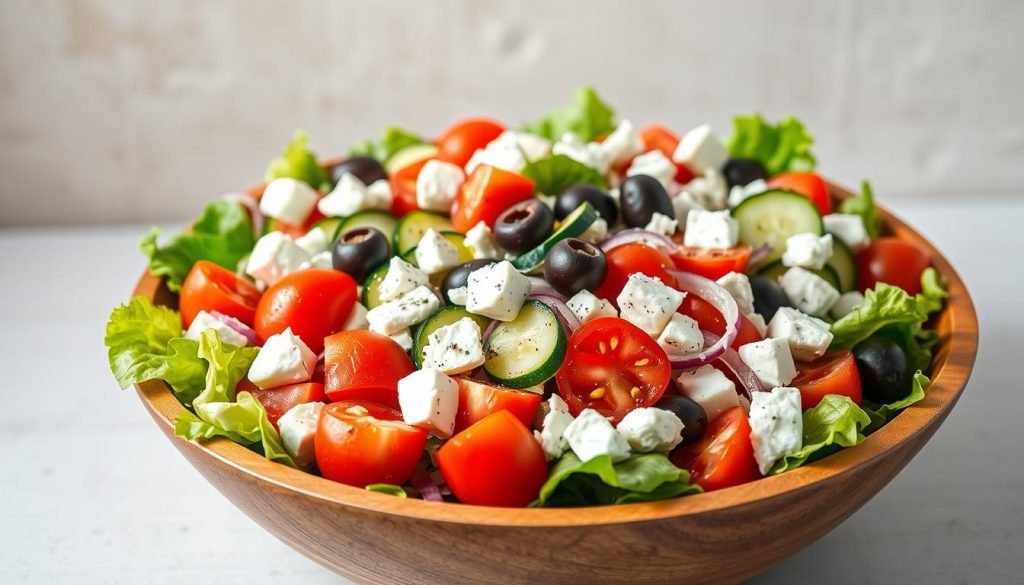
| Customization | Added Ingredients | Prep Time |
|---|---|---|
| Protein-Packed | ¾ cup chickpeas or grilled chicken | +5 minutes |
| Veggie Boost | 1 cup artichokes, ½ avocado | +3 minutes |
| Vegan Version | Vegan cheese, nutritional yeast | +2 minutes |
The beauty of Greek Salad is its flexibility. Feel free to mix ingredients for your perfect taste. With these ideas, you can have a new Greek Salad every time!
Proper Storage Tips for Greek Salad
Keeping your Greek Salad fresh is key. The right storage techniques help your easy recipes last longer. They also keep the salad crisp.
Best Practices for Keeping Ingredients Fresh
Store your Greek Salad ingredients separately in airtight containers in the fridge. This keeps vegetables crunchy. It also stops feta cheese from getting bad tastes.

- Wash and dry vegetables thoroughly before storing
- Keep tomatoes at room temperature until sliced
- Store cucumbers wrapped in a paper towel to absorb excess moisture
- Place olives in brine in a sealed container
- Keep feta cheese in its original packaging or submerged in brine
How Long Can You Store Leftovers?
If your Greek Salad is dressed, eat it within 1-2 days. Undressed salad parts can last longer:
| Ingredient | Storage Duration |
|---|---|
| Chopped vegetables | 3-4 days |
| Feta cheese | 5-7 days |
| Olives | 1-2 weeks |
| Dressing (separate) | Up to 1 week |
For the best taste and texture, make your Greek Salad just before eating. This way, you get a fresh, crisp salad every time. It’s great for your healthy eating routine.
Serving Suggestions for Greek Salad
Greek Salad is great as a main dish or a side. Its fresh taste goes well with many foods. Here are some fun ways to serve this Summer Salad favorite.
Perfect Pairings with Main Dishes
Greek Salad goes well with grilled meats and seafood. Try it with grilled chicken souvlaki for extra protein. Grilled salmon is also a good choice.
For a vegetarian option, try it with falafel. It’s full of protein and calories. You can also add grilled halloumi cheese for more protein.
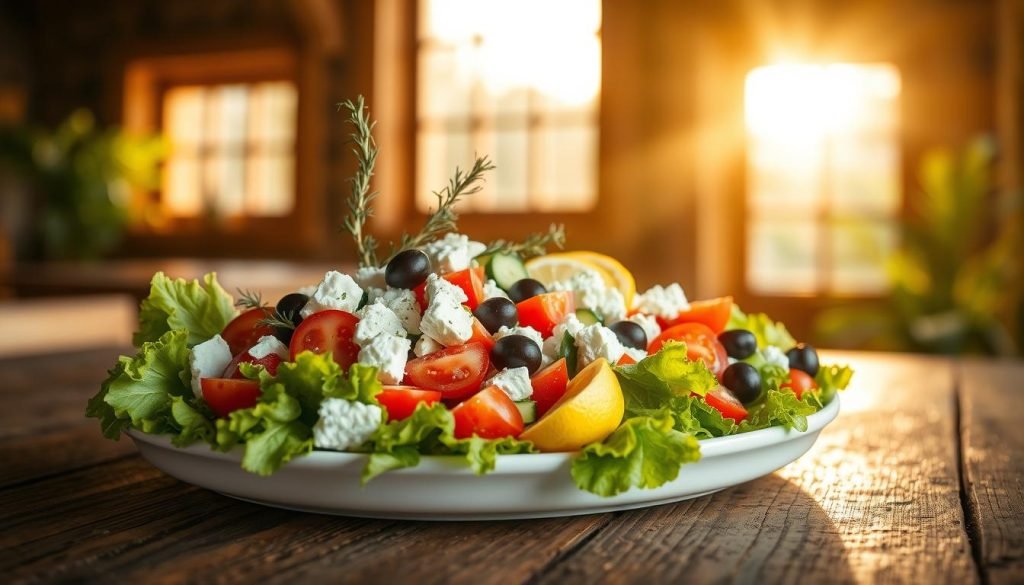
Creative Ways to Serve It at Parties
Make your Greek Salad the hit of the party with these ideas:
- Individual portions in mason jars for easy grab-and-go
- A colorful salad bar where guests can customize their Greek Salad
- Mini pita pockets stuffed with Greek Salad for a fun finger food
- Skewers alternating Greek Salad ingredients for a unique presentation
For a Mediterranean-inspired spread, serve your Greek Salad with hummus and air fryer pita chips. This makes a great mezze platter that will wow your guests.
| Dish | Calories | Protein (g) |
|---|---|---|
| Greek Salad (per serving) | 334 | 3 |
| Grilled Chicken Souvlaki | ~300 | 26 |
| Salmon (3 oz) | ~177 | 22 |
| Falafel (per serving) | 150-200 | 5 |
Conclusion: Enjoying Your Greek Salad Creation
You’ve learned how to make a tasty Greek salad. It’s not just a side dish. It’s a healthy meal that can be a big part of your diet. Greek salad is quick, easy, and full of fresh ingredients.
Encouragement to Experiment with Shares
Don’t be shy to make your Greek salad your own. Add grilled chicken or shrimp for more protein. Try capers or anchovies for a salty taste. Greek salad is very flexible, perfect for any meal.
Final Thoughts on Making It Part of Your Diet
Adding Greek salad to your meals is a great way to eat healthy. It has about 8-10 grams of carbs, great for low-carb diets. It’s full of veggies, olive oil, and feta cheese, making it very nutritious. So, get ready to make your own Greek salad today!
1 thought on “Greek Salad Recipe: Simple & Healthy”